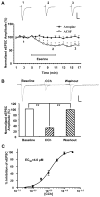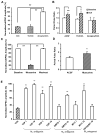Presynaptic muscarinic M(2) receptors modulate glutamatergic transmission in the bed nucleus of the stria terminalis
- PMID: 22166222
- PMCID: PMC3269526
- DOI: 10.1016/j.neuropharm.2011.11.013
Presynaptic muscarinic M(2) receptors modulate glutamatergic transmission in the bed nucleus of the stria terminalis
Abstract
The anterolateral cell group of the bed nucleus of the stria terminalis (BNST(ALG)) serves as an important relay station in stress circuitry. Limbic inputs to the BNST(ALG) are primarily glutamatergic and activity-dependent changes in this input have been implicated in abnormal behaviors associated with chronic stress and addiction. Significantly, local infusion of acetylcholine (ACh) receptor agonists into the BNST trigger stress-like cardiovascular responses, however, little is known about the effects of these agents on glutamatergic transmission in the BNST(ALG). Here, we show that glutamate- and ACh-containing fibers are found in close association in the BNST(ALG). Moreover, in the presence of the acetylcholinesterase inhibitor, eserine, endogenous ACh release evoked a long-lasting reduction of the amplitude of stimulus-evoked EPSCs. This effect was mimicked by exogenous application of the ACh analog, carbachol, which caused a reversible, dose-dependent, reduction of the evoked EPSC amplitude, and an increase in both the paired-pulse ratio and coefficient of variation, suggesting a presynaptic site of action. Uncoupling of postsynaptic G-proteins with intracellular GDP-β-S, or application of the nicotinic receptor antagonist, tubocurarine, failed to block the carbachol effect. In contrast, the carbachol effect was blocked by prior application of atropine or M(2) receptor-preferring antagonists, and was absent in M(2)/M(4) receptor knockout mice, suggesting that presynaptic M(2) receptors mediate the effect of ACh. Immunoelectron microscopy studies further revealed the presence of M(2) receptors on axon terminals that formed asymmetric synapses with BNST neurons. Our findings suggest that presynaptic M(2) receptors might be an important modulator of the stress circuit and hence a novel target for drug development.
Copyright © 2011 Elsevier Ltd. All rights reserved.
Figures









Similar articles
-
Presynaptic 5-HT(1B) receptor-mediated serotonergic inhibition of glutamate transmission in the bed nucleus of the stria terminalis.Neuroscience. 2010 Feb 17;165(4):1390-401. doi: 10.1016/j.neuroscience.2009.11.071. Epub 2009 Dec 3. Neuroscience. 2010. PMID: 19963045 Free PMC article.
-
Cholinergic modulation of primary afferent glutamatergic transmission in rat medullary dorsal horn neurons.Neuropharmacology. 2013 Dec;75:295-303. doi: 10.1016/j.neuropharm.2013.07.030. Epub 2013 Aug 13. Neuropharmacology. 2013. PMID: 23954675
-
Norepinephrine modulates glutamatergic transmission in the bed nucleus of the stria terminalis.Neuropsychopharmacology. 2005 Apr;30(4):657-68. doi: 10.1038/sj.npp.1300639. Neuropsychopharmacology. 2005. PMID: 15602500
-
Modulation of glutamatergic synaptic transmission in the bed nucleus of the stria terminalis.Prog Neuropsychopharmacol Biol Psychiatry. 2009 Nov 13;33(8):1329-35. doi: 10.1016/j.pnpbp.2009.05.022. Epub 2009 Jun 11. Prog Neuropsychopharmacol Biol Psychiatry. 2009. PMID: 19524008 Free PMC article. Review.
-
The response of neurons in the bed nucleus of the stria terminalis to serotonin: implications for anxiety.Prog Neuropsychopharmacol Biol Psychiatry. 2009 Nov 13;33(8):1309-20. doi: 10.1016/j.pnpbp.2009.05.013. Epub 2009 May 23. Prog Neuropsychopharmacol Biol Psychiatry. 2009. PMID: 19467288 Free PMC article. Review.
Cited by
-
Electron microscopic localization of M2-muscarinic receptors in cholinergic and noncholinergic neurons of the laterodorsal tegmental and pedunculopontine nuclei of the rat mesopontine tegmentum.J Comp Neurol. 2016 Oct 15;524(15):3084-103. doi: 10.1002/cne.24010. Epub 2016 Apr 21. J Comp Neurol. 2016. PMID: 27038330 Free PMC article.
-
Distribution and functional expression of Kv4 family α subunits and associated KChIP β subunits in the bed nucleus of the stria terminalis.J Comp Neurol. 2014 Feb 15;522(3):609-25. doi: 10.1002/cne.23435. J Comp Neurol. 2014. PMID: 24037673 Free PMC article.
-
Contrasting distribution of physiological cell types in different regions of the bed nucleus of the stria terminalis.J Neurophysiol. 2013 Nov;110(9):2037-49. doi: 10.1152/jn.00408.2013. Epub 2013 Aug 7. J Neurophysiol. 2013. PMID: 23926040 Free PMC article.
-
Sexually diergic hypothalamic-pituitary-adrenal axis responses to selective and non-selective muscarinic antagonists prior to cholinergic stimulation by physostigmine in rats.Brain Res Bull. 2018 Mar;137:23-34. doi: 10.1016/j.brainresbull.2017.11.002. Epub 2017 Nov 7. Brain Res Bull. 2018. PMID: 29122691 Free PMC article.
-
Cell-type specific deletion of GABA(A)α1 in corticotropin-releasing factor-containing neurons enhances anxiety and disrupts fear extinction.Proc Natl Acad Sci U S A. 2012 Oct 2;109(40):16330-5. doi: 10.1073/pnas.1119261109. Epub 2012 Sep 19. Proc Natl Acad Sci U S A. 2012. PMID: 22992651 Free PMC article.
References
-
- Adamec R. The relationship between the amygdala and bed nucleus of the stria terminalis in the cat: an evoked potential and single cell study. Behav Neural Biol. 1989;52:295–320. - PubMed
-
- Alves FH, Crestani CC, Resstel LB, Correa FM. Cardiovascular effects of carbachol microinjected into the bed nucleus of the stria terminalis of the rat brain. Brain Res. 2007;1143:161–168. - PubMed
-
- Aoki C, Kabak S. Cholinergic terminals in the cat visual cortex: ultrastructural basis for interaction with glutamate-immunoreactive neurons and other cells. Vis Neurosci. 1992;8:177–191. - PubMed
-
- Bellingham MC, Berger AJ. Presynaptic depression of excitatory synaptic inputs to rat hypoglossal motoneurons by muscarinic M2 receptors. J Neurophysiol. 1996;76:3758–3770. - PubMed
Publication types
MeSH terms
Substances
Grants and funding
LinkOut - more resources
Full Text Sources

